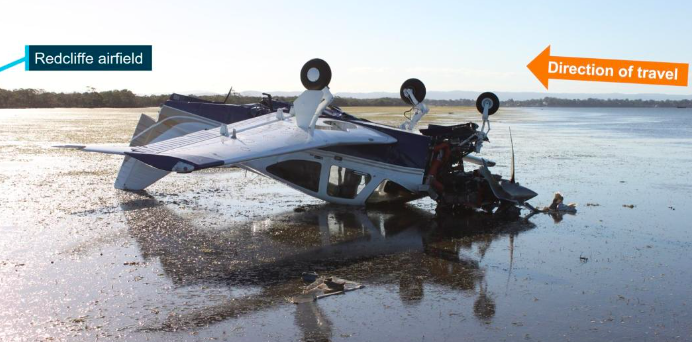Lessons Learned: Fuel Starvation, Fatalities

Fuel starvation and collision with water involved Rockwell International 114, VH-WMM, 1km north of Redcliffe aircraft landing area, Queensland.
The pilot of a single-engine Rockwell Commander aircraft that impacted the water following fuel starvation had not completed all pre-take-off checks including fuel tank selection due to distraction, an ATSB (Australian Transport Safety Bureau) investigation has found.
The four-seat Commander 114, with a pilot and three passengers on board, had departed Redcliffe airfield, north of Brisbane, on the morning of December 19, 2021, the investigation report details.
Prior to the flight the aircraft had been stored in a hangar, during which time most of the fuel moved into the right wing tank. The pilot would have been aware of the fuel imbalance from measuring fuel in both tanks via a dipstick before flight. However, it was likely that the fuel tank selection prior to take-off was to the left fuel tank only.
A video of the accident flight taken on a passenger’s mobile phone showed that while conducting the engine run-ups, the pilot perceived a technical difficulty with the aircraft, and the checks were paused. After notifying a ground crew member by phone, the pilot taxied back toward the ground crew who was walking toward the aircraft on the taxiway.
The ground crew member recalled that through hand signals, the pilot identified the issue as misidentification of the mixture control for the propeller pitch control and communicated that they had identified and corrected the problem.
The pilot then taxied again for the runway without continuing or restarting the interrupted pre-take-off checks.
Shortly after take-off, the engine lost power and the pilot elected to return to the airfield. During the return, the aircraft lost altitude and contacted the water, overturning and coming to rest inverted in about 2 m of water. The occupants were unable to escape the aircraft and were fatally injured.
“During preparation for the flight, the perceived engine problem distracted the pilot during the conduct of pre-take-off checks,” said ATSB Director Transport Safety Dr. Stuart Godley.
“After rectifying the issue, the pilot did not complete the remaining pre-take-off checks, including fuel tank selection, before departure.”
It was likely that the fuel tank selection prior to take-off was to the left fuel tank only, which led to fuel starvation and engine stoppage soon after take-off, the investigation found.
“Likely experiencing the effects of stress and time pressure following the engine power reduction and then stoppage, the pilot did not conduct initial emergency actions and attempted to return to the runway for landing,” said Dr. Godley.
However, the pilot did not maintain glide speed, and the aircraft impacted shallow water prior to reaching the airfield. The extension of the undercarriage for the intended landing then contributed to the aircraft overturning.
This likely resulted in occupant disorientation and added difficulty in operating the exits, reducing their ability to escape. The investigation also notes that it is very likely that the passengers did not receive information about the brace position or actions to be taken in the event of a ditching as part of the pre-flight briefing. Further, in the limited time available inflight after the power loss, the pilot also did not provide an emergency briefing or any instructions to passengers prior to impact with the water.
“This tragic accident highlights the importance of using checklists as they provide pilots with the detailed normal and emergency checks specific to the aircraft type without having to rely on committing these to memory,” Dr. Godley said.
“This ensures that aircraft are operated in a way that meets aircraft flight manual requirements and limitations.
“When distracted, restarting an interrupted checklist from the beginning is a means of ensuring that all steps to be performed are done so in order and the checklist is complete.”
Read the report: Fuel starvation and collision with water involving Rockwell International 114, VH-WMM, 1km north of Redcliffe aircraft landing area, Queensland, on 19 December 2021, publication date: 3/14/2024.



